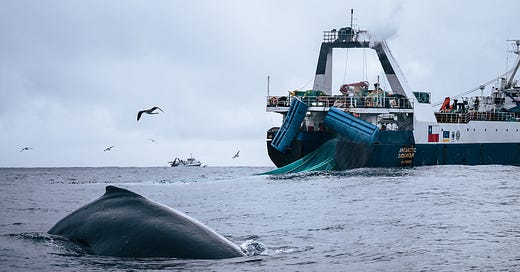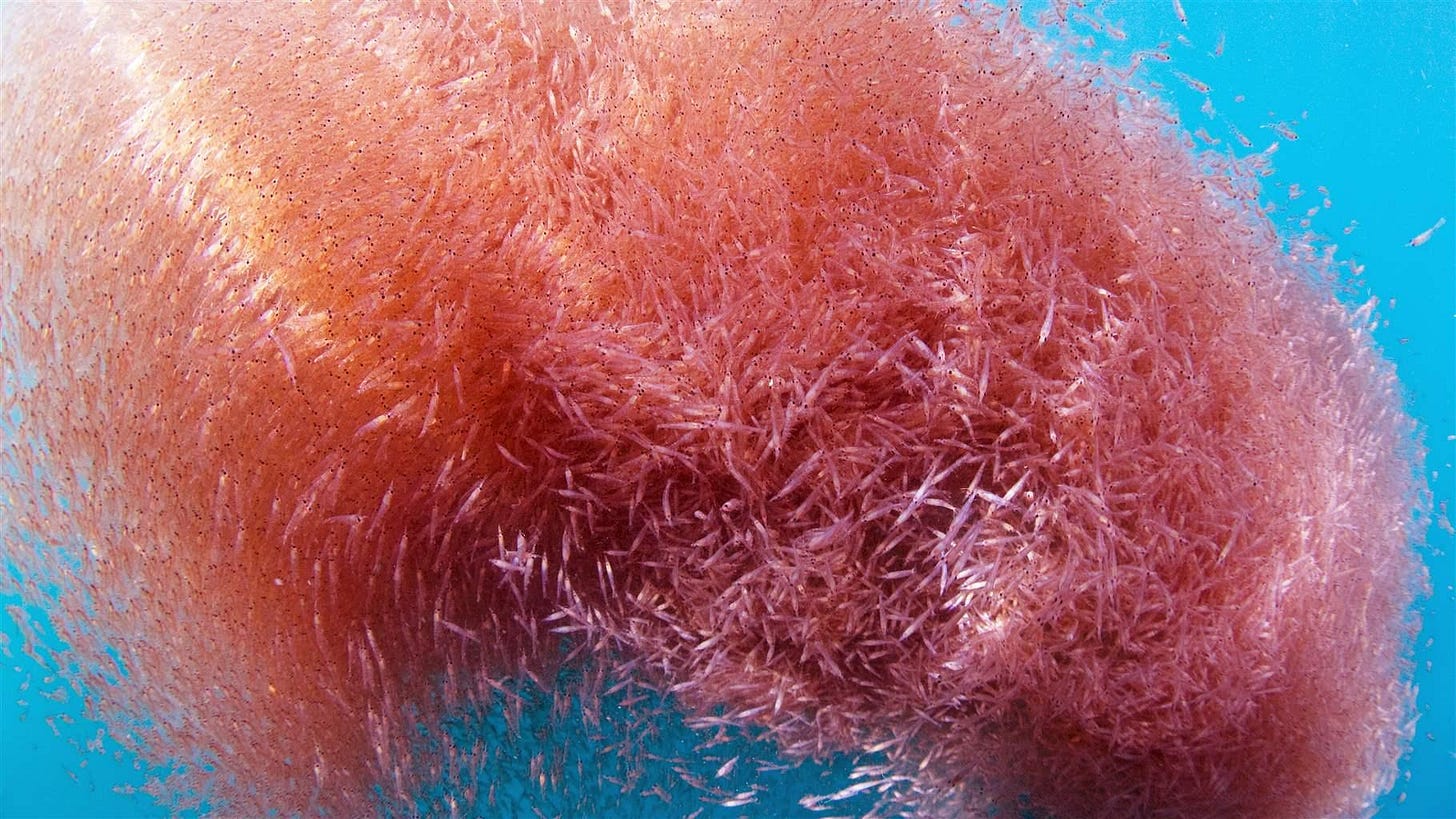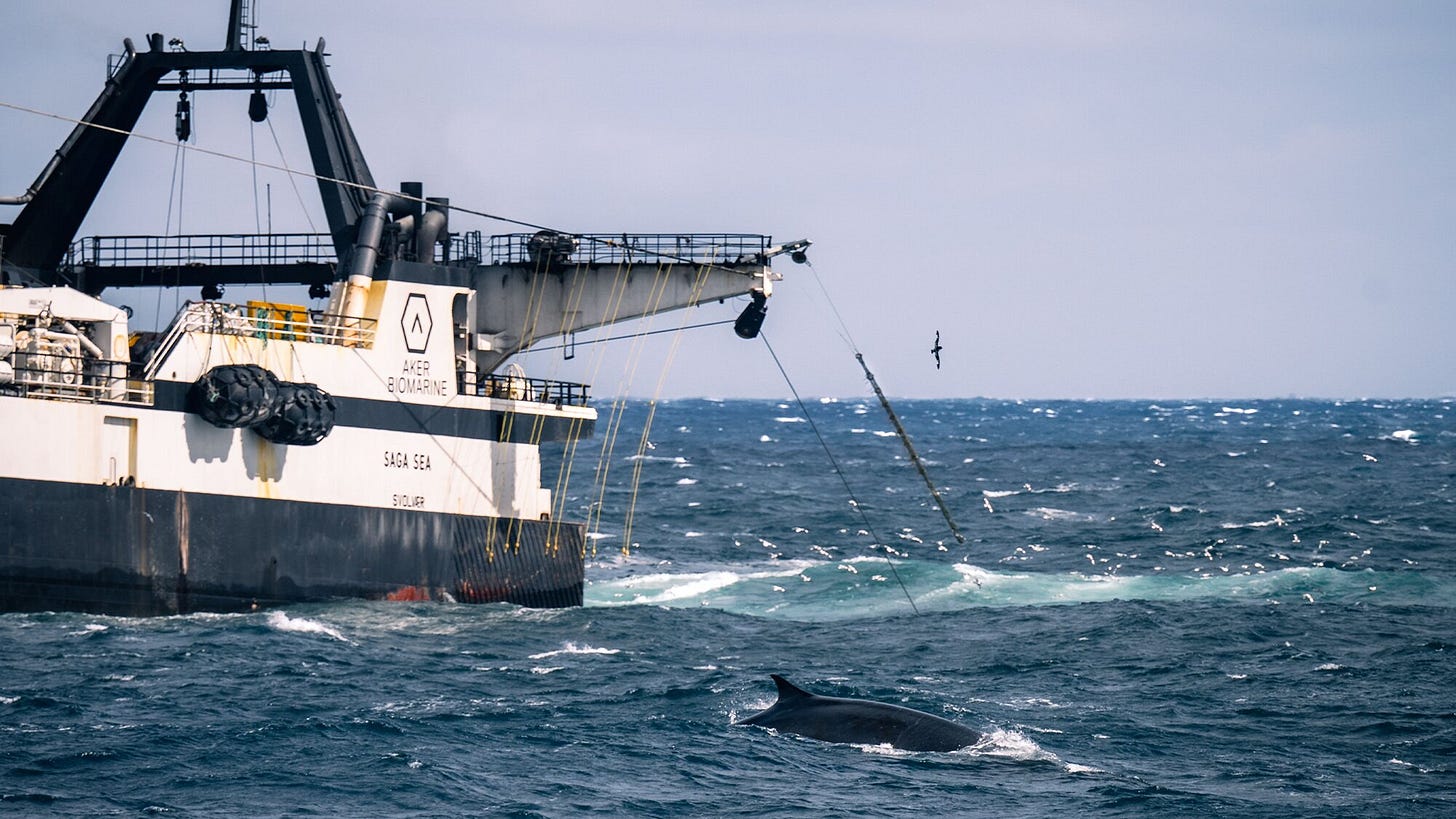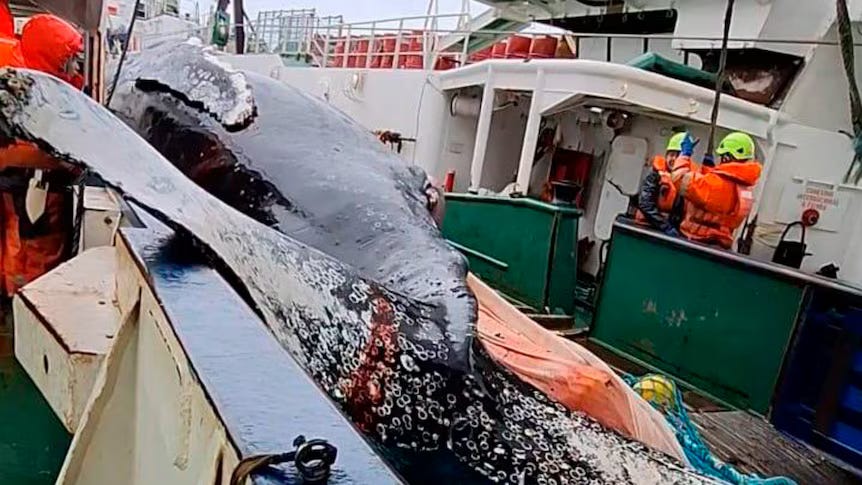When you’re as tiny as krill and the ocean is as vast as it is, it’s a wonder these shrimp-like crustaceans are able to swarm together like they do, never mind find enough to eat. Luckily, certain ocean conditions aid in their mass-gatherings, making it easier for them to find concentrations of food, easier for them to be food for other predators, and increasing their remarkable ability to sequester carbon.
Exactly how they achieve all of this is through the process of upwelling. As the cold, nutrient-rich waters of the deep ocean rise to meet the sunlit surface it acts as a fertiliser for the microscopic marine algae, phytoplankton. Phytoplankton, though at the base of the ocean food chain, are essential in keeping marine ecosystems balanced and healthy and as the primary food source for krill—krill swarms go where they do1.
These conditions are especially pronounced in the Southern Ocean, where the combination of strong circumpolar currents, seasonal sea ice melt, and the constant mixing of ocean layers creates some of the most productive feeding zones on the planet. That’s why so many krill end up here and why Antarctica is home to one of the greatest gatherings of marine life anywhere on Earth.
Krill swarms are most concentrated around the Antarctic Peninsula, the South Orkneys, and South Georgia—areas rich in phytoplankton and thus well-known hotspots for migrating whales. It’s in these fertile waters that ocean ecosystems thrive as penguins, seals, and whales enjoy the bounty of phytoplankton and krill blooms.
Essentially, in the Southern Ocean everything either eats krill or eats something that eats krill.
This is unsurprising given the sheer scale of them in the Southern Ocean—it’s estimated there are around 700 trillion individuals in this ocean alone. For context, 700 trillion pinky-sized crustaceans is enough to wrap around the earth one million times, and with an overall mass of more than 400 million tonnes they are collectively the same weight as all of the people on the planet!
Small in size, gargantuan in impact.
And that impact extends far beyond being a food source too. Thanks to the great abundance of krill they play a major part in the carbon sequestration of the global ocean. As phytoplankton absorb atmospheric CO₂ at the surface, when krill ingest this it is later released in the form of dense faecal pellets which sink to the seabed and effectively lock the carbon away for centuries. Known as the ‘biological pump’, this process is one of the most important ways the ocean is able to keep our planet cool and krill are a huge player. Even in death they contribute, sinking to the seabed and taking carbon with them.
All of this is to say, krill would be greatly missed should anything happen to them. As a key carbon sequesterer at the heart of the Antarctic [and many other] food web(s), their disappearance would create a ripple effect across ecosystems, destabilising populations and forcing species to adapt, move, or die.
Interestingly, more recent studies revealed a symbiotic twist whereby whales don’t just need krill, krill need whales too. When whales disappeared from the area due to historic whaling, scientists expected their number one prey species to explode in population. However, they found the opposite to be true. Krill populations actually declined due to their reliance on the iron levels found in whale faeces. Despite being nutrient-rich, Antarctic waters have an iron-deficiency and rely on the iron that whale faeces provides to supply species like krill, who suffered without it.
It’s a perfect example of the delicate balance within nature—one we’re now actively tipping.
Krill populations have declined by around 80% over the last 50 years, largely due to the loss of sea ice that they use as both a nursery and food source, warming waters shifting their habitat south, and ocean acidification disrupting their ability to reproduce. But they have a new problem too.
Today, industrial krill fishing is the largest fishery in the Antarctic by catch size and in the last 20 years demand has doubled. The krill are harvested en masse to produce omega-3 supplements and fishmeal to feed farmed salmon—supplying consumers while whales go without.
The fishing takes place almost exclusively in the same regions of the Southern Ocean where krill swarms are most concentrated. Fishing fleets will target the densest krill swarms for the same reason whales do, because it’s the most energy-efficient way to catch them. However, unlike whales, these trawlers don’t just skim the surface for their catch, they use massive nets and sophisticated tracking technology to relentlessly hoover up as much of the swarm as they can across multiple days.
These floating factories can continuously harvest for weeks at a time, offloading their catch as they go and practically snatching it from the mouths of those who need it most. The problem isn’t solely how much is being taken, but how and where exactly it’s happening. Fishing is heavily concentrated precisely where marine life gathers to feed meaning the overlap is creating direct competition between whales and supertrawlers for the best swarms. Scientists worry this overlap will also create competition between endangered species as well as still-recovering whale populations. Local fur seals have decreased by 86% since 2007 as they heavily rely on krill during summer breeding months and now have to search further afield to find food. Humpbacks are typically only in Antarctica during the summer season to fatten up on krill before they migrate north to breed, fasting for their winter journey. Krill fisheries operate during summer when the weather is more agreeable for them.
Matthew Savoca, an ecologist at Stanford University’s Hopkins Marine Station, put it plainly: “It’s not as though we’re taking their food now, but they’ll get a bunch more, when the boats are gone. That is not how it works for these animals.” Though the fisheries argue that healthy humpback populations are a sign that their allowance of only <1% of actual krill biomass to be fished is ‘highly precautionary’, Savoca argues that these fisheries are taking the ‘best’ 1%, aka the easiest to find and catch: “so it’s going to make it harder for the whales”.
The issue goes beyond competition as in recent years, several humpback whales have died after becoming entangled in krill fishing nets, with at least three confirmed deaths in 2024 alone. One vessel, the Antarctic Endeavour, is now the subject of a criminal complaint in Chile after a humpback was found dead in its trawl net. This ship and around seven other supertrawlers were fishing in what is a proposed marine protected area, some notably displaying the Marine Stewardship Council’s ‘ecolabel’, awarded to fisheries they deem ‘sustainable’. But as Sea Shepherd has stressed many times, there is no such thing as sustainable krill fishing.
This isn’t just a case of stealing someone’s food, whales, especially humpbacks, fin whales, and blue whales, rely on dense krill swarms to fuel their entire seasonal life cycle. They can go months without feeding as they travel incredible distances, so their brief time spent in Antarctica is critical, allowing them to build fat reserves and produce the energy needed for migration, breeding, and raising their calves in the open ocean. If, when they arrive in the Southern Ocean, the densest swarms of krill are already gone or going, they are subject to the leftovers which are often too dispersed to be energetically viable. This forces them to spend more energy looking for food elsewhere or go without, which can affect their overall health, ability to reproduce, and calf survival—which over time affects the entire species.
Even more concerning, we’re interfering with some whale populations before they’ve had a chance to fully recover from being hunted to the brink across centuries. While humpbacks have almost fully recovered since the end of commercial whaling, blue whales have not, and fin whales are only now beginning to show signs of recovery. Cutting off their food source just as they begin to return is to pull the carpet from underneath their fins.
The mere presence of krill supertrawlers has shown evidence of disrupting the very feeding behaviour that makes krill accessible. Research shows that large aggregations of whales can influence krill to swarm at the surface2 but when those gatherings are disturbed by noise, ship traffic, or direct competition, the krill may never even reach that accessible state—undermining prime feeding conditions for precious marine species.
It seems the quiet danger of krill fisheries is not simply the vast quantities they take but the disruption of key, natural processes which no living thing could go without, nevermind vulnerable species.
The solution lies with the body tasked with overseeing krill fishing in Antarctica, the Commission for the Conservation of Antarctic Marine Living Resources (CCAMLR). The commission was founded on the promise of balancing conservation with growing industry but has too often, especially recently, failed to protect the region. Proposed measures to reduce fishing pressure or to expand marine protected areas have been repeatedly blocked by a handful of member states. Any member country is able to veto a proposed measure and in recent years China and Russia have exploited this rule to actively oppose tighter regulations, all while their trawlers are spotted out in the Antarctic peninsula.
CCAMLR’s current framework allows up to 8.6 million tonnes of krill to be fished in the Southern Ocean every year, yet even its precautionary ‘trigger limit’ of 620,000 tonnes (equivalent to approximately 1% of the estimated krill biomass in this area) is under strain. In 2022, nearly all the krill harvested from Subarea 48.2, which includes the critical feeding ground around South Orkney West, came from just 2% of that area. Not only has krill catch become increasingly concentrated in key foraging zones, transshipments allow these mega-vessels to offload their catch and continue harvesting with little interruption.
And who’s to stop them? The government of South Georgia and the South Sandwich Islands did ban krill fishing between November and March to minimise conflict with krill predators, but this doesn’t cover the peak summer feeding season when most whales are in the area. Similarly, the Association of Responsible Krill Harvesting Companies (ARK) has agreed to stay 40km away from large penguin and pinniped colonies in one region, but again, this is voluntary and ignores the areas where more than 96% of the krill catch now takes place.
Efforts to introduce no-fish zones around whale feeding grounds have either stalled at CCAMLR conferences or remain non-binding with no official measures in place to keep supertrawlers out of protected areas or even monitor their movements. Right now, it’s little more than public scrutiny keeping these supertrawlers from expanding into sensitive, protected areas—if they haven’t already. This isn’t about ending krill fishing altogether, rather demanding that it be truly precautionary: spatially spread out, scientifically informed, and permanently off-limits in key feeding zones. Until new management measures are passed by CCAMLR (or dare I say it, CCAMLR gets a reshuffle), this crossover between whales and krill fisheries will only increase as demand does.
So while we wait for that to happen, we can take matters into our own hands, just a little, by reducing the demand for krill-infused products. For starters, stop buying krill oil and omega-3 supplements – there are plenty of plant-based alternatives available. Also, think twice before trusting the Marine Stewardship Council’s definition of ‘sustainable’ on certain products. And if you still have the energy, shout from the rooftops that all Antarctic waters should be a monitored marine protected area.
Marine life is already quickly losing this final frontier to human hands. If we let it happen, krill fishing will slowly do to Antarctica what deforestation did to the tropical rainforests of Southeast Asia.
Here at Beached we are building a community that can put our brains and resources together to highlight and fund solutions to the problems facing krill, whales and all life in Antarctica. I hope you’ll join our humble community and click subscribe for free or support our work by purchasing the paid subscription.
All Beached posts are free to read but if you can we ask you to support our work through a paid subscription. These directly support the work of Beached and allow us to engage in more conversations with experts in the field of marine conservation and spend more time researching a wider breadth of topics for the newsletters. Paid subscriptions allow us to dedicate more time and effort to creating a community and provide the space for stakeholders to come together, stay abreast of each other’s work and foster improved collaboration and coordination.
One day Beached hope to donate a large percentage of the revenue from paid subscriptions to marine conservation organisations and charities to support their work too. Working together, we can reverse the degradation of our oceans.
Amie 🐋
Krill directly ingest phytoplankton by using their front legs as a filter, ‘collecting’ their tiny prey and pushing them through a one-micron-wide opening into their ‘feeding basket’.
All part of the symbiotic relationship I mentioned earlier.









As Sea Shepherd recommends, the entire Southern Ocean around Antarctica needs to be designated a Marine Protected Area, for all the reasons you detail. Especially the krill & whale population areas!
Take action, get involved: https://www.asoc.org/campaign/marine-protected-areas/
Well done🩵💧🩵